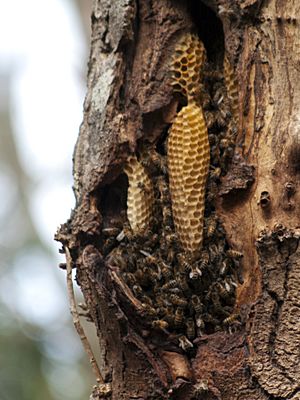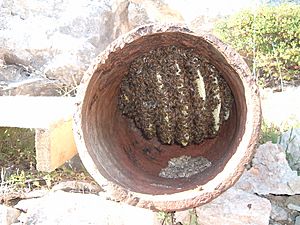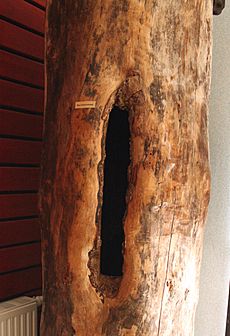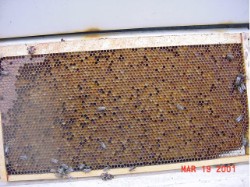Beehive facts for kids
A beehive is a structure in which some species of honey bees (genus Apis) live and raise their young. Natural beehives (or "nests") are made by honey bee colonies, while domesticated honey bees are kept in man-made beehives in a location known as an apiary. The beehives made by people are usually the things referred to by the word "beehive."
Beehives have hexagonal cells in them, packed together. This is called a honeycomb.
Contents
Honey bee nests
Honey bees use caves, rock cavities and hollow trees as natural nesting sites. In warmer climates they may occasionally build exposed hanging nests as pictured. Members of other subgenera have exposed aerial combs. The nest is composed of multiple honeycombs, parallel to each other, with a relatively uniform bee space. It usually has a single entrance. Western honey bees prefer nest cavities approximately 45 litres in volume and avoid those smaller than 10 or larger than 100 litres. Western honey bees show several nest-site preferences: the height above ground is usually between 1 metre (3.3 ft) and 5 metres (16 ft), entrance positions tend to face downward, Equatorial-facing entrances are favored, and nest sites over 300 metres (980 ft) from the parent colony are preferred. Bees usually occupy nests for several years.
The bees often smooth the bark surrounding the nest entrance, and the cavity walls are coated with a thin layer of hardened plant resin (propolis). Honeycombs are attached to the walls along the cavity tops and sides, but small passageways are left along the comb edges. The basic nest architecture for all honeybees is similar: honey is stored in the upper part of the comb; beneath it are rows of pollen-storage cells, worker-brood cells, and drone-brood cells, in that order. The peanut-shaped queen cells are normally built at the lower edge of the comb.
Ancient hives
Bees were kept in man-made hives in Egypt in antiquity. The walls of the Egyptian sun temple of Nyuserre Ini from the 5th Dynasty, dated earlier than 2422 BC, depict workers blowing smoke into hives as they remove honeycombs. Inscriptions detailing the production of honey are found on the tomb of Pabasa from the 26th Dynasty (c. 650 BC), and describe honey stored in jars, and cylindrical hives.
Traditional hives

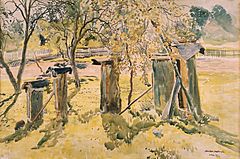
Traditional beehives simply provided an enclosure for the bee colony. Because no internal structures were provided for the bees, the bees created their own honeycomb within the hives. The comb is often cross-attached and cannot be moved without destroying it. This is sometimes called a "fixed-frame" hive to differentiate it from the modern "movable-frame" hives. Harvest generally destroyed the hives, though there were some adaptations using extra top baskets which could be removed when the bees filled them with honey. These were gradually supplanted with box hives of varying dimensions, with or without frames, and finally replaced by newer modern equipment.
Honey from traditional hives was typically extracted by pressing – crushing the wax honeycomb to squeeze out the honey. Due to this harvesting, traditional beehives typically provided more beeswax, but far less honey, than a modern hive.
There are four basic styles of traditional beehive; mud hives, clay/tile hives, skeps and bee gums.
Mud and clay hives
Mud hives are still used in Egypt. These are long cylinders made from a mixture of unbaked mud, straw, and dung.
Clay tiles were the customary homes of kept bees in the eastern end of the Mediterranean. Long cylinders of baked clay were used in ancient Egypt, the Middle East and to some extent in Greece, Italy and Malta. They sometimes were used singly, but more often stacked in rows to provide some shade, at least for those not on top. Keepers would smoke one end to drive the bees to the other end while they harvested honey.
Skeps


Skeps, baskets placed open-end-down, have been used to house bees for some 2000 years. Initially they were made from wicker plastered with mud and dung but from the Middle Ages they were made of straw. In northern and western Europe, skeps were made of coils of grass or straw. In its simplest form, there is a single entrance at the bottom of the skep. Again, there is no internal structure provided for the bees and the colony must produce its own honeycomb, which is attached to the inside of the skep. Skeps have two disadvantages; beekeepers cannot inspect the comb for diseases and pests, and honey removal is difficult and often results in the destruction of the entire colony. To get the honey beekeepers either drove the bees out of the skep or, by the use of a bottom extension called an eke or a top extension called a cap, sought to create comb with just honey in it. Quite often the bees were just killed, sometimes using lighted sulfur, to allow the honeycomb to be removed. Skeps could also be squeezed in a vise to extract the honey. As of 1998, most US states prohibited the use of skeps because they can not be inspected for disease and parasites.
Later skep designs included a smaller woven basket (cap) on top over a small hole in the main skep. This cap acted as a crude super, allowing the harvesting of some honey with less destruction of brood and bees. In England such an extension piece consisting of a ring of about 4 or 5 coils of straw placed below a straw beehive to give extra room for brood rearing was called an eke, imp or nadir. An eke was used to give just a bit of extra room, or to "eke" some more space, a nadir is a larger extension used when a full story was needed beneath.
A person who made such woven beehives was called a "skepper", a surname that still exists in western countries. In England the thickness of the coil of straw was controlled using a ring of leather or piece of cows horn called a "girth" and the coils of straw could be sewn together using strips of briar. Likenesses of skeps can be found in paintings, carvings and old manuscripts. The skep is often used on signs as an indication of industry ("the busy bee").
In the late 18th century, more complex skeps appeared with wooden tops with holes in them over which glass jars were placed. The comb was built in the glass jars, making the designs commercially attractive.
Bee gums
In the eastern United States, especially in the southeast, sections of hollow trees were used until the 20th century. These were called "gums" because they often were from black gum (Nyssa sylvatica) trees.
Sections of the hollow trees were set upright in "bee yards" or apiaries. Sometimes sticks or crossed sticks were placed under a board cover to give an attachment for the honeycomb. As with skeps, harvest of honey from these destroyed the colony. Often the harvester would kill the bees before even opening their nest. This was done by inserting a metal container of burning sulfur into the gum.
Natural tree hollows and artificially hollowed tree trunks were widely used in the past by beekeepers in Central Europe. For example, in Poland such a beehive was called a "barć" and was protected in various ways from unfavorable weather conditions (rain, frost) and predators (woodpeckers, bears, pine marten, forest dormouse). Harvest of honey from these did not destroy the colony, as only a protective piece of wood was removed from the opening and smoke was used to deter the bees for a short time.
Bee gums are still used by beekeepers today, for bee species whose honey output is less than that of the more productive honeybee. Unlike most beehives (which are usable only with Apis mellifera and Apis cerana), the bee gum allows housing of many more bee species. The bee gum allows the bees themselves to organize their nest(nest structure and cells in which to store their honey and pollen).
In some instances, bee gums are also still used, even with bee species that do produce large quantities of honey (i.e. Apis mellifera nigra). However, in these instances, part of the reason why bee gums are then used is that this allows the producers of the honey to distinguish themselves from other honey producers and to ask a higher price for the honey. An example where bee gums are still used is Mont-Lozère, France. The length of the bee gums used are rather on the short side; unlike regular bee gums, the bee gums are hollowed out artificially and cut to a specific size.
Modern hives
The earliest recognizably modern designs of beehives arose in the 19th century, though they were perfected from intermediate stages of progress made in the 18th century.
In 1814 Petro Prokopovych invented the world's first frame hive, which allowed an easier honey harvest.
There are two basic types of modern hive in common use, the movable-frame "Langstroth hive" (including all the size variants) which has enclosed frames to hold the comb and the movable-comb "top-bar hive", which - as the name implies, has only a top-bar to support the comb. Movable frames and movable combs - as opposed to fixed combs - both allow the apiarist to inspect for diseases and parasites and also allow a beekeeper more easily to split the hive to make new colonies.
Bees are more likely to make new comb "correctly" if it already contains frames with some comb or foundation. If only empty frames are present, bees may build comb that does not follow them and cannot be later removed with the frame. Use of a thin strip of wood or plastic inside and at the top of a frame without foundation may serve as a "comb guide" to encourage the bees to build straight comb.
Symbolism
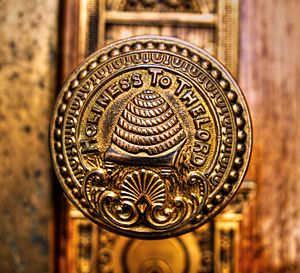
The beehive is a commonly used symbol dating at least to Roman times. In medieval heraldry it was considered a symbol of industry.
In modern times, it is used in Freemasonry. In masonic lectures it is explained as a symbol of industry and co-operation, and as cautioning against intellectual laziness, warning that "he that will so demean himself as not to be endeavoring to add to the common stock of knowledge and understanding, may be deemed a drone in the hive of nature, a useless member of society, and unworthy of our protection as Masons."
The beehive is also used with similar meaning by The Church of Jesus Christ of Latter-day Saints, or Mormons. From Mormon usage it has become one of the State symbols of Utah. (See deseret.)
Relocation
A common misconception of non-beekeepers is that smoke will cause bees to move their nest. Smoke is used by beekeepers to hide the alarm pheromone emitted by bees during inspections or harvest.
One-way traps can be used to reduce the size of a colony, but is a limited and time-consuming solution. Beekeepers and companies may remove unwanted nests from structures, this process is called a "cut out". Once honey, pollen, and wax are built up in a nest, only physical removal is an option. Some homeowners resort to using spray-foam, but the bees will wait and live off reserves until the foam is weakened, then will burrow through it. An important fact in understanding a nest is that fewer than 10% of the bees will ever leave at once, other than when swarming. A fertilized queen will lay up to 2000 eggs a day. If bees are killed and the hive products are left, heat and time will loosen the wax and honey causing further problems in the future.
Destruction
By other natural organisms
Black bears destroy hives in their quest for honey.
Hives erected by humans, as a defense for their crops against elephants, are sometimes destroyed by elephants. These hives are hung on a single metal wire that encircles the crop field of some farms in African elephant territory. The installation is called a BeeHive Fence and was conceived by Lucy King.
By humans
Humans often destroy hives of honey-producing bee species in the interest of obtaining honey and other bee products.
Humans may at times also determine that a beehive must be destroyed in the interest of public safety or in the interest of preventing the spread of bee diseases. The U.S. state of Florida destroyed the hives of Africanized honey bees in 1999. The state of Alaska has issued regulations governing the treatment of diseased beehives via burning followed by burial, fumigation using ethylene oxide or other approved gases, sterilization by treatment with lye, or by scorching. In New Zealand, the treatment of hives infected with the disease American foulbrood with antibiotics is prohibited, and beekeepers are required by law to destroy such colonies and hives with fire.
Method of destruction
Spraying the hive with a solution of soap and water may be effective, since soap dissolves the bees' waxy exterior that protects them from drowning. However, the procedure should be undertaken with caution, as it angers the bees.
Images for kids
-
A beekeeper inspects a hive frame with honeycomb, showing capped honey and brood cells. The modular design allows for easier management and non-destructive harvesting of honey and beeswax.
See also
 In Spanish: Colmena para niños
In Spanish: Colmena para niños



